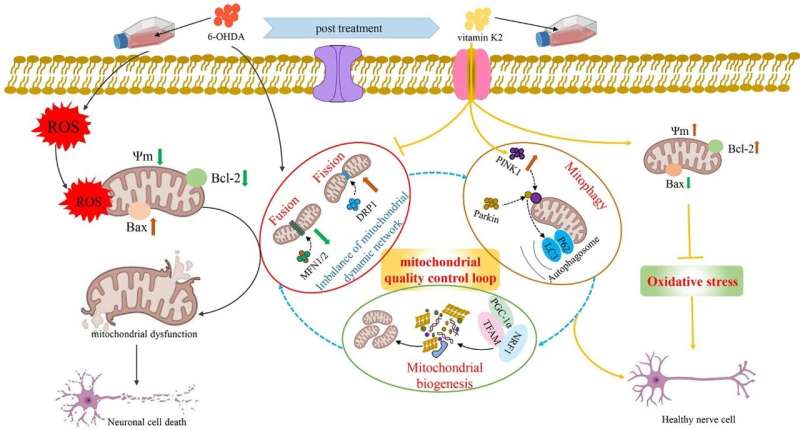Vitamin K2 repairs nerve cells via mitochondrial quality control loop

In a recent study published in Nutrients, a research group led by Prof. Zheng Zhiming from the Hefei Institutes of Physical Science (HFIPS) of the Chinese Academy of Sciences (CAS) has found a novel function of vitamin K2: regulating mitochondrial membrane potential and alleviating oxidative stress, thus repairing mitochondrial dysfunction and inhibiting nerve cell damage caused by 6-hydroxydopamine (6-OHDA).
The antioxidant function of vitamin K2 is a powerful neuroprotective molecule, but its mechanism has not been fully elucidated. The nerve agent 6-OHDA causes degeneration of dopamine neurons, which can lead to mitochondrial damage and nerve cell death. It is often used in the pathogenesis of Parkinson's and other neurodegenerative diseases.
In this research, scientists found that vitamin K2 can inhibit 6-OHDA-caused nerve cell damage by protecting mitochondria.
Vitamin K2 plays the role of the main switch of apoptosis by upregulating the expression of B-cell lymphoma-2 (one of oncogenes in apoptosis research) and downregulating the expression of Bax (the most important apoptotic gene in human body), thus regulating the mitochondrial membrane potential and reactive oxygen species levels and alleviating oxidative stress, according to Dr. Tang Hengfang, first author of the study.
In addition, it maintains the normal operation of mitochondrial fusion, division, autophagy and generation, so as to control the normal operation of the mitochondrial quality control loop and repair damaged mitochondria.
The results show that vitamin K2 may play a role in the prevention and treatment of neurodegenerative diseases such as Alzheimer's disease and Parkinson's disease by repairing nerve cell damage.
More information: Hengfang Tang et al, Vitamin K2 Modulates Mitochondrial Dysfunction Induced by 6-Hydroxydopamine in SH-SY5Y Cells via Mitochondrial Quality-Control Loop, Nutrients (2022). DOI: 10.3390/nu14071504
Provided by Chinese Academy of Sciences



















